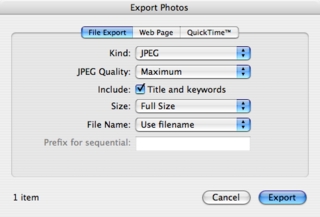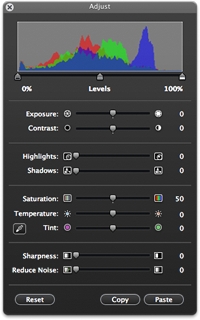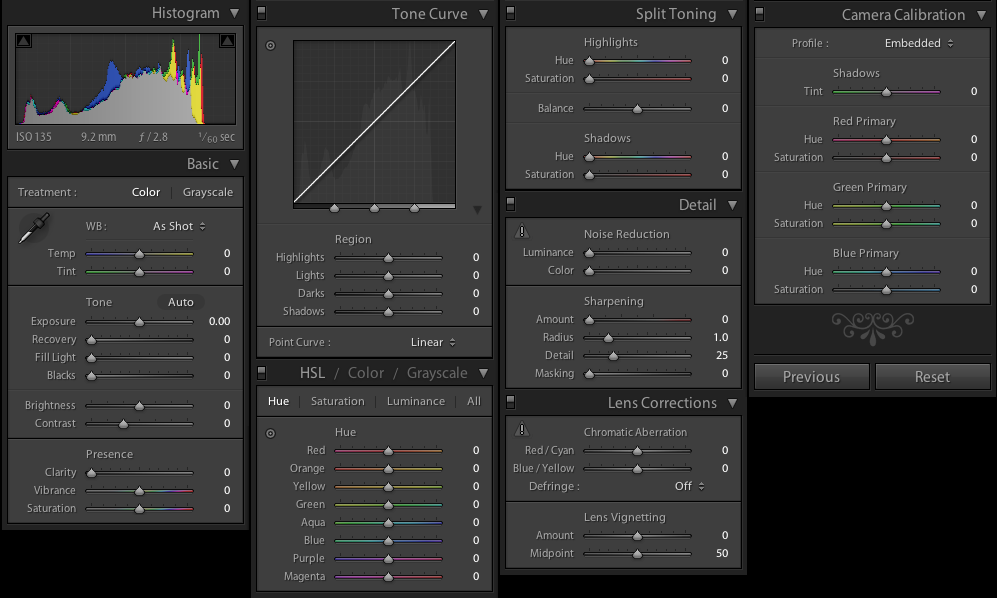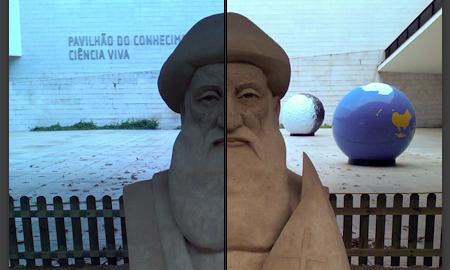There are a million things people take for granted when talking about either Lightroom or iPhoto - for starters, that one is a professional tool and the other is a toy.
Update: Since most people seem to be approaching this piece with some kind of bias and missing the point, allow me to say that:
1) Yes, I know 1GB of RAM is not ideal. Get off your high horse, I’m not going to pay Eur.110 or so to try out new software, and Lightroom isn’t slow because of lack of RAM, not when handling JPEG files.
2) I’m not comparing apples to oranges - I’m trying to figure out if it makes sense (for me, not necessarily for you) to move up to professional photo editing software or if there is enough middle ground between iPhoto and Lightroom to give rise to some sort of “semi-pro” category that caters to my needs (better color management, halfway decent metadata management, and not blowing away too much cash on hardware and software).
There is never a one-size-fits-all solution for this kind of thing, and if your setup works for you, that’s great.
But toys can become quite sophisticated, and professional tools tend to go mainstream as technology matures - plus photography is a field where that distinction is fast blurring, to a point.
Mac users, in particular, have been caught between iPhoto’s “toy” features and sophisticated high-end photo workflow management tools like Aperture and Lightroom, which are now undergoing the usual incremental update phase until their creators figure out what the market really wants - but which have already split the semi-pro photographer blogs into two very distinct (and not entirely peaceful) factions.
The thing is, both of those cost US$299 - well above a hobbyist’s reach. Except, of course, if you can justify the expense somehow (and, in a hobbyist context, you often need to do so to other people besides yourself).
Other tools exist, but most are either tuned to particular niches or do not cover (or try to cover) the whole gamut of photo processing from importing to archival and management. Given that Lightroom avoids the “opaque library” approach I dislike in Apple products, I went ahead and got the Lightroom 30 day trial.
As a sort of historical side note, one of the most promising low-end solutions, iView Media Pro has been acquired by Microsoft and turned into Expression Media (also at US$299), so that puts it squarely in the same ballpark as Lightroom, but without both the mystique and the advanced editing features.
My Requirements and Pet Gripes
I have modest needs when it comes to photo processing - for starters, I try to avoid doing photo manipulation by actually thinking while taking photos (I hear it’s the whole purpose of the exercise). Since I do not have a very powerful zoom lens, the most common editing operation I perform is cropping, closely followed by immediate export into my own date-based archival system.
But nobody is perfect, and as such I often find myself tuning exposure and highlights on photos that are “nearly there” but that have some detail obscured by a mistake in the camera settings. And since I am constantly playing around with camera phones that have bad (or inexistent) white balance controls, every time I want to salvage one of those photos I have to run it through some sort of image editing application.
And so far, iPhoto has been completely useless at both handling my editing needs and actually managing photos. And by managing I mean being able to manipulate the images’ metadata directly, not squirreling it all away in its own database - there’s more to managing data than delivering a nice UI to it (you actually have to know what you’re doing to the data itself).
Because, you see, iPhoto libraries are probably one of the most obtuse, inflexible and counter-intuitive ways to manage your photos when, like me, you want the actual metadata to be an integral part of the photo itself - and this is something I’ve been wrestling with for quite a while now.
I had some hope that Apple would see the light and change the way iPhoto (and Aperture) handle that, but the current behavior is by design, and even though I’ve been corresponding with a few folk that already have iPhoto‘08 and were able to indulge me in testing out the new keyword management on some test files and send me the results, I remain unfazed.
To cut a very long story short, iPhoto‘08 now has a simple keyword/tagging mechanism that appears to not completely suck, and will insert titles and keywords as EXIF metadata when you export files:

Despite the obvious limitations, I was able to confirm that it can at least export titles and keywords in “Unicode, for the resulting files were tagged with Roman, Cyrillic and Chinese characters and I was able to view and manipulate the results correctly in exiftool.
The Editing Story, and Why I Tried Lightroom
But let’s get back to editing. iPhoto has always been somewhat of a bad joke where it concerns color tuning - although its “enhance” button makes some reasonable guesses as to what a photo should look like, the results are generally amateurish and over-saturated (and, to be honest, a lot unlike the sample photos we’re used to seeing in Apple sample galleries).
Version ‘08 added a white balance picker and slightly more sophisticated exposure and level controls, and although I have not tried them myself, I’ve seen the result on a couple of camera phone photos (the white balance picker, in particular, seems to do most of what I regularly need to do):

But however much of an improvement this happens to be upon the previous versions, it is clearly a toy when compared to the wide range of controls you find in Lightroom:

Now, I will freely admit to being biased, since I used Photoshop from version 2.0 or so onwards for quite a few years, and I like the fine degree of control Adobe tools usually provide.
But in this, like in so many instances, images are worth a thousand words. After importing a few photos, I tried my hand at editing a few images, like this camera phone image:

…and quite a few other normal photos, like this slightly over-exposed flower:

And although I barely scratched the surface in these two examples (the other photos are not for public consumption), the bottom line, as far as editing is concerned, is that “Lightroom’s“:apps/Lightroom Tone Curve and its other tools are light-years ahead of anything that iPhoto is able to do.
Although iPhoto‘08 now sports a white balance picker and separate sliders for high/low/mid tones, Lightroom allows for a level of fine control that it simply cannot match (unless Apple downsizes some of Aperture’s tools, which it isn’t likely to).
The Management Angle
I won’t go into all the details (there are plenty more detailed reviews out there), but Lightroom does three things near perfectly right:
- It does not mess up
RAWfiles or generateJPEGduplicates until I ask it to (unlike iPhoto, which creates pointless duplicates at the drop of a hat). - It has no trouble in accessing 7 years of photos (roughly 10GB) over the network
- It actually knows how to edit
EXIFandIPTCmetadata and save it back to files in a sensible fashion - better still, it will include all your color tuning efforts in the metadata itself.
I cannot stress these enough - iPhoto is simply not suitable for anything but casual photography until it is able to do these things, and I wouldn’t even call adding my photos into iPhoto “managing” them at this point. It’s more like tossing them into a bag and having it fill up with extraneous junk.
And yes, I know I can get iPhoto to import files into the library without copying them - i.e., keeping the originals on a remote share, which it auto-mounts if necessary - but what use is that if any editing I apply to the photo results in a locally stored duplicate???
The Catch
Lightroom does, however, have a significant drawback for me: It’s very slow, as in bordering on the unresponsive.
Maybe it’s the bits written in Lua (or maybe not), but while trying to navigate 3000 locally stored photos on my iMac G5 (1.8GHz, 1GB RAM), things often ground to a halt–it took several seconds for a double-clicked image to become available for developing, and I often overshot the color values I wanted because the display took seconds to update while dragging the sliders - and this without anything else running.
Note that this does not necessarily have to do with the size of the library - I’m talking about the time required to retrieve a photo and have it available for developing.
Although my MacBook is faster, I rely on the iMac for photography work due to its 20” display - plus there are things that I simply don’t do on a laptop.
And it isn’t as if I’m demanding that much out of the G5 - Fireworks has a serviceable (if finicky) level curve apparatus and several similar color tuning options, and I find it quite responsive when dealing with 8 megapixel PEG files.
As a side note, my quest for something to replace my ailing copy of Fireworks MX may soon be at an end, but that’s another story altogether. Suffice it to say that Photoshop CS3 is out of my reach (even though I added it to my Amazon UK wishlist, and that there are some interesting things afoot.
And that kind of contradicts the main point of buying new software - i.e., to improve the way you do things. I can’t justify paying US$299 (or Eur.301.29 inc. VAT) for something that, despite doing a lot more than iPhoto, does not deliver the same kind of user experience (which is the only thing Apple has down pat, and which I hope wasn’t impacted by the extra frills in the ‘08 version).
This might yet change over the next 20 days or so (especially considering that I’ve barely even begun to explore RAW and DNG support), but I can’t really see myself pay that much money for a tone curve and a few extra doodads, not when they work that slowly on my current hardware setup.
bq. Yes, yes, I could always add more RAM, if that were the problem. Which it is not, at least according to top and Activity Monitor. And it would also cost me at least a third of what Lightroom does, bringing the whole thing up to Eur. 400 or so.
There’s also the slim chance I can keep working around iPhoto’s most glaring limitations using the tools I have (and my patience), but the performance issues and the high cost are the two major put-offs from what is otherwise an obviously superior way of doing photography on the Mac.
Closing Notes
The most irritating thing so far?
Well, there was the little matter of iPhoto‘08 coming out three days after I started trying out Lightroom and typed out the first outline of this piece, and the slow realization that Apple had not really fixed any of the issues with it (with the possible exception of photo tagging).
But to add insult to injury, while asking folk in the US for some specifics on iPhoto‘08 and swapping sample files to and fro, it was pointed out to me that the GIMP (for which I have an almost legendary distaste) sports a somewhat adequate level curve palette.
As such, it behooves me to point that out here as well, before the Linux zealots start coming out of the woodwork and point out that it runs on Mac OS X (omitting the fact that it, heinously, relies on X11 to work there, which renders it nearly twice as unusable).
And yes, I know of the native ports. In particular, the GTK port has been going on like, forever. It’s obviously a complex endeavor, and there have been some promising signs on the Imendio Forum (for starters, Wireshark can be compiled against it) but it’s not quite all there yet.
So don’t bother mentioning it in regards to shelling out US$299 for a tone curve.
All things considered, I’d rather wait until Adobe sees fit to update Photoshop Elements - but I’m not holding my breath for that one, either.
But I do hope to have more on image editing applications in a few weeks - check back then.